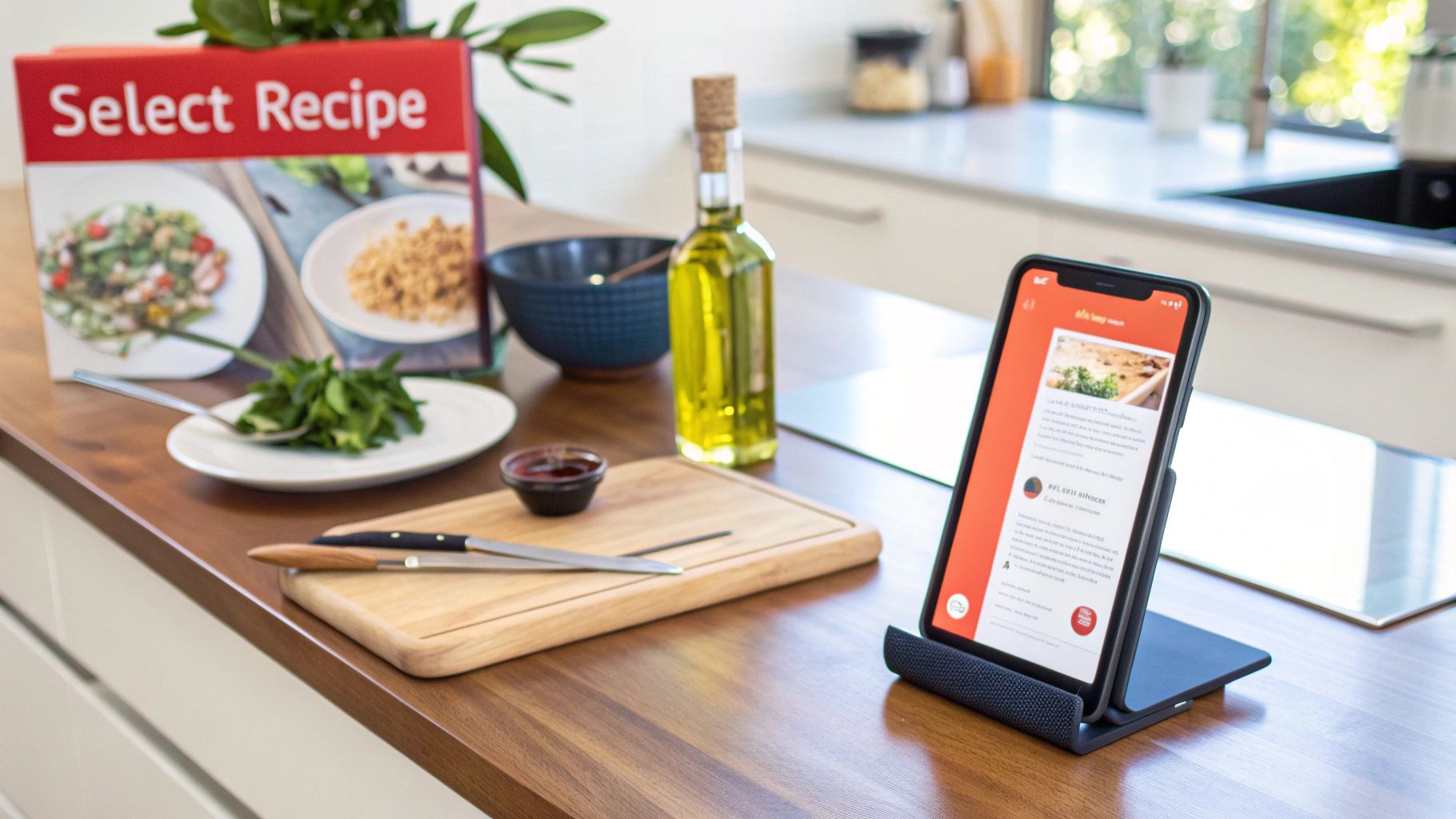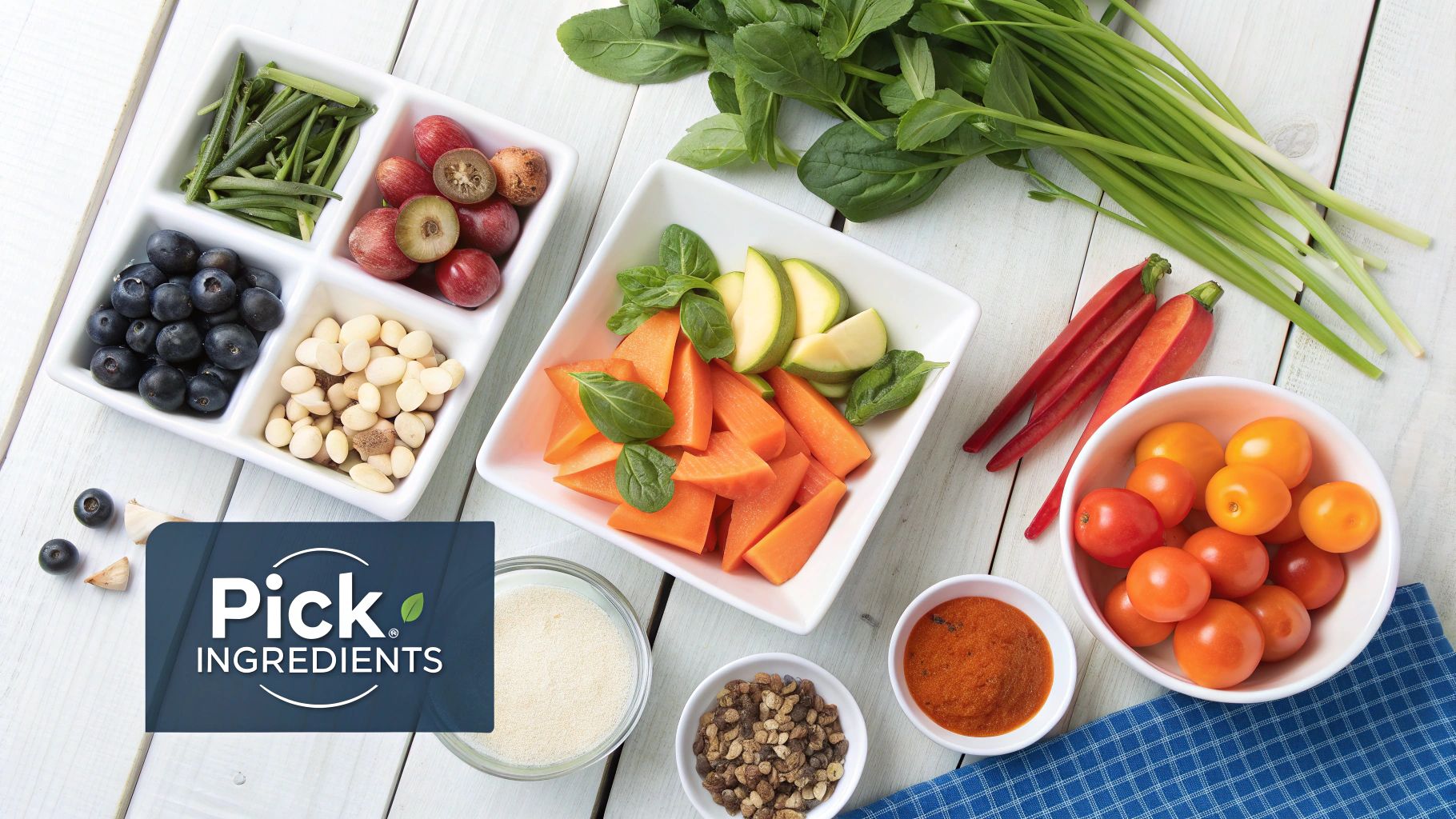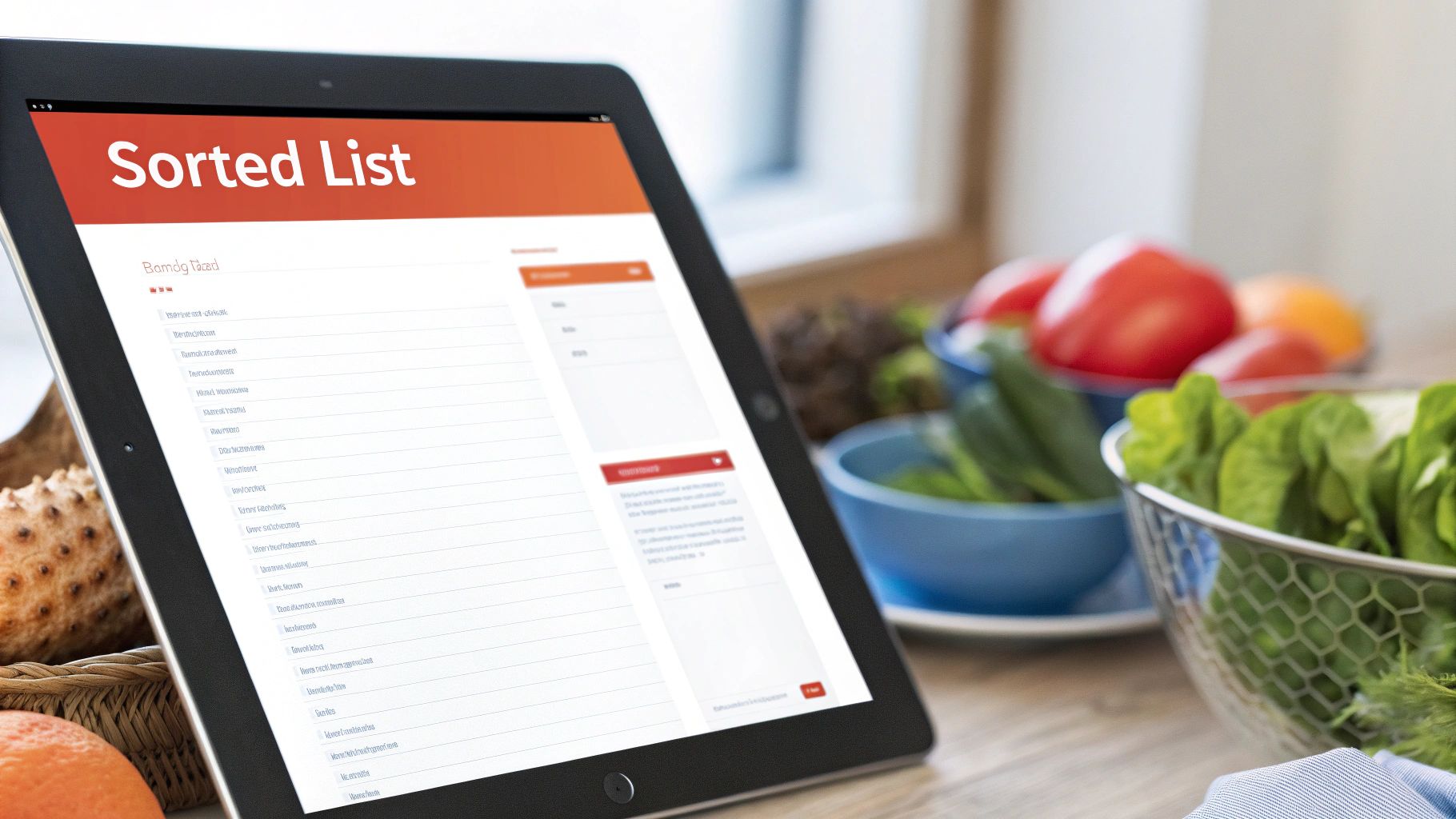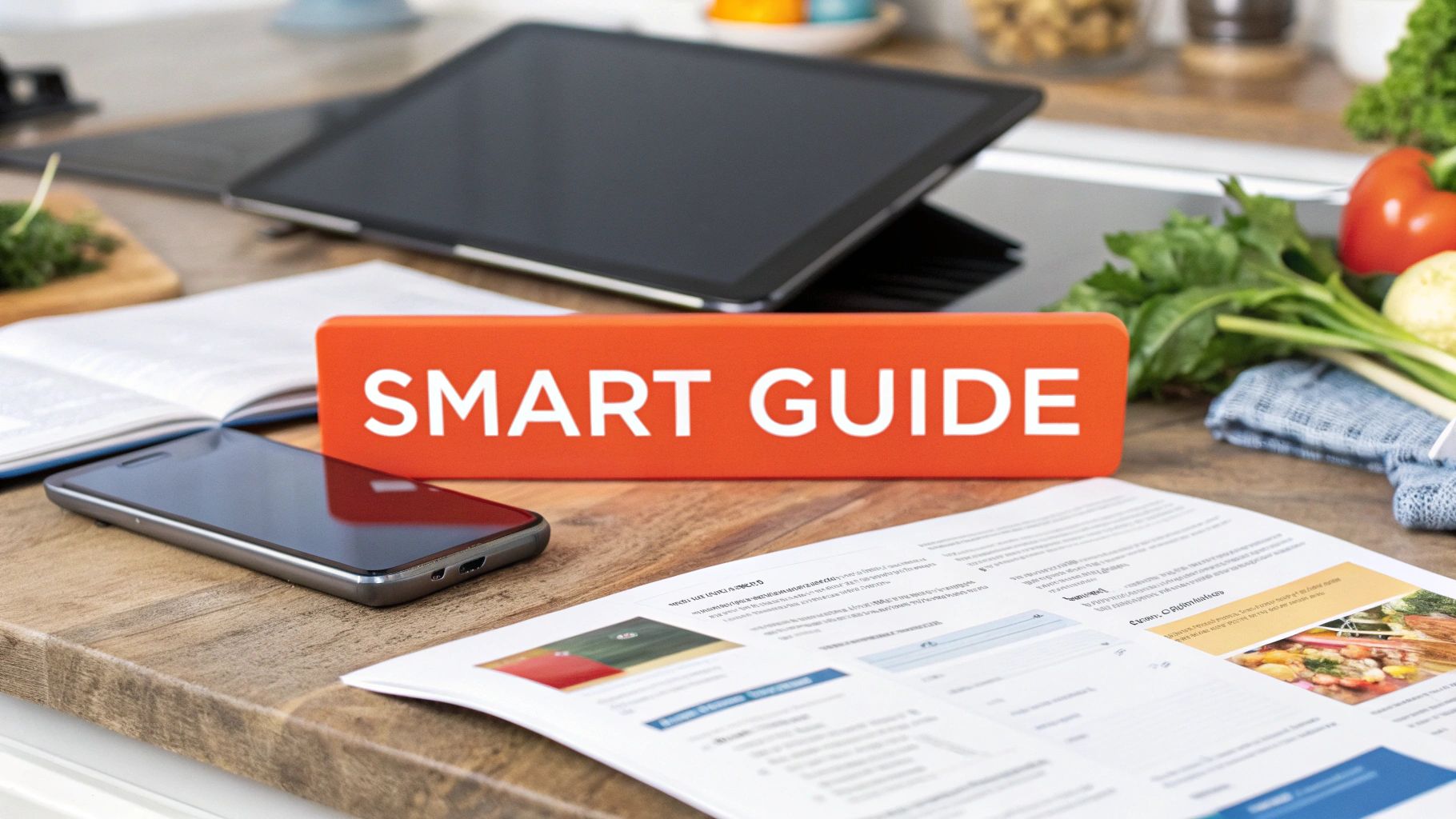Why Smart Shoppers Generate Lists From Recipes

Let's face it – wandering through grocery store aisles often leads to impulse buys and forgotten essentials. This traditional approach can be inefficient and contribute to food waste. Generating shopping lists directly from recipes transforms meal planning. This method streamlines shopping trips and offers several key advantages.
Imagine planning a week of meals. Instead of mentally juggling ingredients, a recipe-based list consolidates everything. This prevents duplicate purchases and reduces those frustrating mid-week store runs. It also keeps your pantry more organized. Plus, a pre-planned list helps avoid decision fatigue at the store. You'll spend less time wondering what to buy and more time focusing on quality ingredients. For tips on creating a grocery list, check out this helpful resource: How to master creating a grocery list.
This approach also positively impacts food waste. By purchasing only what's needed, you reduce the chances of produce spoiling. Studies suggest this method can reduce food waste by up to 40%. This saves money and supports a more sustainable lifestyle, benefiting the average household both financially and time-wise.
Streamlining Meal Management with Digital Tools
Generating your shopping list from recipes adds organization to your kitchen and reduces the mental load of meal management. This lets you enjoy cooking rather than stressing over logistics. In recent years, this method has gained popularity thanks to platforms like AnyList. AnyList simplifies grocery management. Users can add recipe ingredients directly to their lists, making meal planning and shopping more efficient.
This shift towards digital management also saves time. Features such as suggested items, automatic categorization, and shared lists dramatically reduce planning and shopping time. As of early 2025, AnyList had over 1 million downloads on Google Play, showing the widespread adoption of such tools. Explore AnyList further here.
For more content creation and online strategy insights, visit the inblog.ai blog. Using recipes to create shopping lists offers numerous benefits, making grocery shopping less of a chore and more strategic. For additional tips, see our guide on how to organize recipes digitally. This can further enhance your culinary journey.
Digital Tools That Transform Recipe Shopping

From scattered notes to a streamlined shopping list, digital tools are changing how we shop for recipes. These platforms simplify meal planning by automatically gathering ingredients from your chosen recipes. This eliminates frantic list-making and mental juggling in the grocery store. Efficient shopping starts with meal planning. Learn more about how to start meal planning.
Key Features of Recipe-Based Shopping List Generators
Several key features make these tools essential for the modern kitchen. They excel at recognizing ingredients and converting measurements. Many platforms also offer pantry inventory tracking, so you can check what you have before shopping.
Some apps allow barcode scanning or voice input to add items to your digital pantry. This reduces duplicate purchases and helps manage expiration dates. You might be interested in: How to master organizing recipes digitally.
Many apps also handle recipe scaling with ease. If you're cooking for a crowd, simply adjust the serving size, and the app updates the shopping list. This saves you time and prevents errors. Some even accommodate dietary restrictions, letting you filter recipes and exclude specific ingredients.
Choosing the Right Tool for Your Needs
Not every shopping list generator is the same. Some excel at ingredient recognition; others prioritize pantry management. Consider your needs and cooking style when choosing a platform.
- Ease of Use: Look for intuitive interfaces and simple navigation. A complicated app can be discouraging.
- Recipe Integration: Seamless integration with your favorite recipe sources (websites, apps, personal collections) is important.
- Shopping List Features: Consider list sharing, aisle organization, and adding notes or substitutions.
To help you choose, we've compiled a comparison of popular apps:
The following table provides a comprehensive comparison of leading applications for creating shopping lists from recipes, evaluating their key features, pricing, and unique selling points.
| App Name | Key Features | Price | User Rating | Best For |
|---|---|---|---|---|
| AnyList | Recipe import, pantry tracking, list sharing | Free, with premium features | 4.8 stars | Families and collaborative cooks |
| Mealime | Meal planning, recipe recommendations, grocery delivery integration | Free, with premium features | 4.7 stars | Busy individuals and health-conscious eaters |
| Paprika Recipe Manager 3 | Recipe organization, meal planning, pantry management | One-time purchase | 4.6 stars | Serious home cooks and recipe collectors |
| BigOven | Recipe clipping, meal planning, grocery list generation | Free, with premium features | 4.5 stars | Recipe enthusiasts and budget-conscious cooks |
| Plan to Eat | Recipe import, meal planning, drag-and-drop interface | Subscription | 4.4 stars | Organized meal planners and families |
This table highlights the diverse features and pricing models available, allowing you to select the app best suited to your individual needs. Consider factors like recipe management, pantry tracking, and sharing capabilities when making your decision.
Technology integration in grocery shopping has significantly reduced food waste and increased efficiency. Samsung Food's grocery list generator turns recipes into shopping lists instantly, streamlining the process. This helps users plan better and avoid unnecessary purchases, reducing waste.
The Food and Agriculture Organization (FAO) of the United Nations found that roughly one-third of all food produced globally is lost or wasted. Tools like Samsung Food help consumers reduce this statistic by buying only what they need. Organizing lists by aisle or recipe allows for quicker store navigation. Learn more about Samsung Food's efficiency features.
By considering these factors, you can choose a tool that integrates seamlessly into your routine and simplifies shopping list creation. These apps empower smarter shopping, reduce food waste, and save valuable time.
The Analog Approach: Crafting Lists Without Apps

While apps offer convenience, many find satisfaction and control in the tangible process of handwritten lists. This section explores how to effectively generate shopping lists from recipes using analog methods. These time-tested techniques are favored by culinary professionals and organized home cooks alike. This approach allows for a deeper understanding of your recipes and ingredient needs.
Step-by-Step Guide to Manual List Creation
Creating a shopping list manually isn't complicated. It involves a systematic approach to ensure accuracy and efficiency. Here’s a simple guide to get you started:
-
Gather Your Recipes: Assemble all the recipes you plan to use for the week. This provides a clear overview of your ingredient requirements.
-
Extract Ingredients: Carefully list each ingredient from every recipe onto a piece of paper or a dedicated notebook. Note the required quantity for each.
-
Consolidate and Standardize: Combine identical ingredients, adding their quantities together. For example, if two recipes call for onions, combine the amounts into a single entry. Be sure to standardize measurements (convert all amounts to cups, ounces, etc.).
-
Organize by Category: Group similar items together (produce, dairy, grains, etc.). This mirrors your store's layout, making shopping more efficient.
-
Check Your Pantry: Before finalizing the list, check your pantry and refrigerator for existing ingredients. Cross off anything you already have. This minimizes waste and saves money.
This simple process creates a focused shopping list while ensuring you have everything needed for your chosen recipes. This methodical approach makes your shopping trip significantly more efficient.
Practical Tips for Analog List Management
Several techniques enhance manual list creation. These practices optimize organization and ensure your shopping trip is as streamlined as possible.
-
Color-Coding: Assign different colors to different categories (e.g., green for produce, blue for dairy). This makes items easier to locate on the list and in the store.
-
Store Layout Map: Create a simplified map of your grocery store, noting the locations of different sections. Arrange your list accordingly, further optimizing your shopping route. This prevents aimless wandering and saves valuable time. You could even use a meal planner notebook to help: How to maximize meal planner notebooks.
-
Template Creation: Design a reusable template with pre-printed categories. This standardizes your lists and saves time on setup each week. You can even create a digital template and print copies: Creating digital grocery lists.
These analog methods make list generation surprisingly efficient and satisfying. They enhance meal preparation by streamlining grocery shopping. They provide a structured way to generate shopping lists from recipes without relying on technology.
Handling Specialty Items and Bulk Purchases
Analog methods offer flexibility when dealing with unique ingredients. Create a separate "specialty" section on your list for less common items. This prevents overlooking them during your shopping trip.
For bulk purchases, note the quantity needed and the best price per unit. This ensures you’re getting the most value while meeting your recipe requirements.
These tips help maintain order and control over your ingredient needs, even for complex or large-scale cooking projects. This meticulous approach ensures you're prepared for any culinary endeavor.
Mastering the Art of List Optimization

Creating a shopping list from your recipes is a good first step. But to really make your shopping trips efficient, you need list optimization. Think of it as prepping your ingredients before you cook. This section covers advanced techniques to refine your recipe-generated lists. You'll learn how to spend less time in the store and improve your meal planning. These strategies go beyond simply jotting down ingredients. They're about planning and organization.
Categorizing By Store Section and Perishability
Organizing your list by store sections is a major time saver. Instead of one long list, group items by category: produce, dairy, pantry, and so on. This mirrors the store's layout so you can shop methodically, avoiding unnecessary backtracking. For more tips on recipe organization, which directly impacts your shopping list's efficiency, check out this guide on how to organize recipes digitally.
Also, think about perishability. Put delicate items like fresh herbs and berries at the top of your list. This ensures they are purchased quickly and stored properly. This helps maintain freshness and reduces food waste.
Building Flexibility Into Your List
Sometimes, your preferred items are unavailable or the prices have skyrocketed. Having a flexible list prevents these issues from derailing your meal plans. List both your preferred ingredient and an alternative. If a recipe calls for asparagus, list green beans as a backup. This simple step avoids last-minute changes if your first choice isn't available or affordable.
Seasonal availability is another factor. Fruits and vegetables are often fresher and cheaper when they're in season. Adapt your recipes and shopping lists to take advantage of these seasonal deals. You'll save money and add variety to your meals.
Smart Quantity Management and Shopping Path Optimization
Buying too much leads to waste, while buying too little means extra trips to the store. Use your recipes as a guide for quantities and consider your household’s consumption habits. Buying pantry staples in bulk can save money, especially if you use them often. Just be sure to check expiration dates and consider storage space.
Plan your shopping route, just like you'd plan a road trip. Organize your list to minimize extra walking and backtracking. This saves time and energy, particularly in larger supermarkets.
Integrating Sales and Bulk Purchases
Take advantage of sales and bulk buying opportunities. If an item on sale fits into your meal plan, adjust your list accordingly. For example, if chicken is on sale and you're planning a chicken dish, double the recipe and freeze half for later.
Managing Specialty Ingredients and Pantry Staples
Specialty ingredients often require a trip to a specific store or section. Create a separate section on your list for these items so you don't forget them. Keeping an inventory of pantry staples also prevents unnecessary purchases. Maintain a list of your most-used spices, oils, and grains, noting when they need replenishing.
Before you head to the store, take a look at this table outlining different ways to organize your shopping list. It highlights the pros and cons of each method, helping you choose the best approach for your needs.
Shopping List Organization Systems
| Organization Method | Best For | Time Saving Potential | Learning Curve | Tips for Implementation |
|---|---|---|---|---|
| By Store Section | Frequent shoppers, large stores | High | Low | Group items by store layout (produce, dairy, etc.) |
| By Recipe | Meal preppers, complex recipes | Medium | Low | List ingredients for each recipe separately |
| By Ingredient Type | Simple meals, small stores | Low | Low | Group similar items (e.g., all vegetables together) |
| Hybrid (Store Section + Perishability) | Optimized efficiency, reducing waste | High | Medium | Combine store sections with prioritizing perishables |
This table helps illustrate how choosing the right organization method can significantly improve your shopping efficiency. The hybrid method, combining store sections and perishability, often provides the best results for both time-saving and reducing food waste.
Streamlining Your Shopping Experience
Optimizing your shopping list turns grocery shopping from a chore into a streamlined process. By using these strategies, you’ll reduce food waste, save money, and enjoy a more organized kitchen. These tips empower you to take control of your meals and shopping. For those who appreciate a traditional approach, explore our guide on how to maximize the use of meal planner notebooks. This offers valuable insights into analog meal planning and list organization. This method provides a tangible and personalized way to structure your meals and shopping trips.
Scaling Up: Managing Multi-Recipe Meal Plans
Planning a single meal and generating a shopping list is a great starting point. But the real power of this method comes into play when planning multiple recipes for a week or even a month. While this can seem daunting, the right approach makes managing multi-recipe meal plans surprisingly straightforward. This section explores techniques used by meal prep pros to navigate the complexities of multi-recipe shopping lists.
Tracking Ingredients Across Multiple Recipes
Keeping track of all the ingredients for numerous recipes can be a challenge. A simple and effective solution is creating a master list. List every ingredient for each recipe, then combine like items. For example, if three recipes call for onions, add those amounts together for a single entry on your master shopping list. This streamlines your list and ensures you buy the right amount, avoiding both running short and having too much.
Preventing Waste Through Strategic Ingredient Usage
Minimizing food waste is another important aspect of multi-recipe meal planning. Look for recipes that share ingredients. Theme-based meal planning can be very useful here. A "Mediterranean week" could include several recipes using ingredients like olives, feta cheese, and tomatoes. This focused approach simplifies shopping and reduces the chance of perishable ingredients going to waste.
Maintaining Variety and Simplifying Shopping
While efficiency is important, meal planning shouldn’t sacrifice variety. Theme-based planning, as discussed above, provides a great balance. Another strategy is choosing recipes with similar cooking methods. For example, select several slow cooker recipes for the week if you plan to use your slow cooker. This saves time and allows for more strategic shopping. You might also find this helpful: How to maximize meal planner notebooks.
Balancing Family Preferences and Dietary Needs
Family preferences and dietary needs can add another level of complexity. Set up a system where everyone can contribute recipe ideas. This encourages participation and minimizes mealtime complaints. For dietary restrictions, consider separate lists for specific needs. If a family member is gluten-free, create a separate gluten-free shopping list alongside your main one. This clear separation avoids confusion and ensures everyone’s dietary requirements are met.
Adaptable Frameworks for Weekly and Monthly Planning
The basic principles remain the same, whether you’re a weekly or monthly meal prepper. Begin with a clear plan, create your shopping list, and stay flexible. For weekly prepping, focus on perishables and consider pre-chopping ingredients. For monthly planning, prioritize shelf-stable items and plan themes around seasonal produce. This guarantees freshness and helps reduce waste.
These methods transform multi-recipe planning from a potentially overwhelming task into a manageable one. They give you control over your grocery shopping and meal preparation, simplifying the process of generating shopping lists from multiple recipes. This leads to more efficient shopping trips, less food waste, and ultimately, more enjoyable meals.
Overcoming Common Shopping List Obstacles
Generating a shopping list from recipes dramatically improves grocery shopping efficiency. However, even the best systems can encounter real-world challenges. This section provides practical solutions for common obstacles you might face.
Handling Inconsistent Measurements and Ingredient Names
Recipes aren't always consistent. One might call for "1 tbsp olive oil," while another uses "15ml." A consistent system is key for generating accurate shopping lists. Establish a standard unit of measurement (e.g., grams, ounces, milliliters) and convert all recipe quantities accordingly.
This prevents confusion at the store and ensures you buy the correct amounts. Ingredient names can also vary. Is it "bell pepper," "capsicum," or "sweet pepper"? Create a personal ingredient glossary or use a digital tool with ingredient standardization.
This creates uniformity across your recipes and simplifies your shopping list. This is similar to how professional chefs maintain detailed inventories for their kitchens, ensuring consistency and minimizing waste.
Managing Specialty Ingredients and Seasonal Availability
Some recipes require specialty ingredients not readily available in every store. Plan ahead by checking your local stores’ inventories or searching online retailers. Consider substitutions if needed.
This proactive approach prevents last-minute recipe changes and keeps your meal plans on track. Seasonal availability also impacts your shopping list. If a recipe calls for fresh berries in winter, be prepared to substitute frozen or another fruit entirely.
This adaptability is essential for managing expectations and maintaining a practical approach to meal planning.
Adapting to Store Formats and Recipe Modifications
Not all stores are laid out the same. Organize your shopping list according to your preferred store's layout. Group items by category (produce, dairy, pantry, etc.) to minimize backtracking.
Just as chefs organize their kitchens for efficient workflow, structuring your list can save valuable time during your shopping trip. Recipe modifications also require list adjustments. If you decide to double a recipe or omit an ingredient, update your shopping list accordingly.
Digital tools often automate this, but even with a handwritten list, taking a moment to revise ensures accuracy.
Minimizing Waste by Managing Partial Ingredients
Sometimes recipes call for only a portion of an ingredient. For example, a recipe might need half an onion, leaving you with the other half. Plan ahead by incorporating the remaining portion into another meal within the same week.
This resourceful approach minimizes food waste and maximizes the value of your purchases. This thoughtful approach to ingredient management can significantly reduce waste and contribute to a more sustainable kitchen.
Troubleshooting and Workarounds
Even with careful planning, you might encounter frustrating issues. Perhaps a recipe calls for a vague quantity ("a pinch of salt") or an ingredient is unavailable. Experienced cooks develop workarounds.
For vague quantities, rely on your culinary judgment or consult online resources for guidance. For unavailable ingredients, consider substitutions or check alternative stores.
By addressing these common obstacles and adopting practical solutions, you can enhance the effectiveness of your recipe-generated shopping lists and enjoy a smoother, more efficient shopping experience. These techniques help experienced cooks stay organized and maintain control of their meal planning, even when facing unexpected challenges.
The Future of Recipe-to-Shopping Innovation
The way we create shopping lists from recipes is constantly changing. We've gone from handwritten lists organized by grocery store aisles to digital apps that track our pantry staples. The process has become much more sophisticated. But what's next? New technologies are ready to change how we plan, shop, and cook. This evolution will make creating shopping lists from recipes even more intuitive and personalized.
AI-Powered Pantry Management and Recipe Modification
Imagine an AI suggesting recipe modifications based on what you already have. This technology is becoming a reality. AI is learning to understand your preferences and dietary needs, offering personalized recipe suggestions. These personalized suggestions can minimize waste and maximize efficiency. Your smart refrigerator could soon be your personal culinary assistant. For example, if you have leftover chicken and vegetables, your AI might suggest a stir-fry. It could automatically create a shopping list for the missing ingredients. This dynamic approach to meal planning offers a new level of personalization.
Smart Refrigerators and Real-Time Inventory Tracking
Smart refrigerators are changing inventory tracking. These appliances can track expiration dates and automatically add items to your shopping list when you're running low. This eliminates manual pantry checks, ensuring you have the ingredients you need. Real-time inventory tracking also helps prevent overbuying. Your smart fridge will know if you already have three cartons of milk, preventing you from buying another. This means less waste and a more efficient grocery budget.
Augmented Reality and The In-Store Experience
Augmented reality (AR) is changing the in-store experience. Imagine walking through the grocery store and seeing information about products overlaid on the shelves through your phone's camera. AR could highlight sales related to your shopping list, show you where specific ingredients are located, or even provide nutritional information. This technology will make grocery shopping a more interactive experience. For example, imagine seeing a virtual map guiding you to the cashews you need for your homemade cashew butter. This level of precision simplifies shopping and saves time.
Voice Technology, Predictive Analytics, and Integrated Delivery
Voice assistants are increasingly integrated into our kitchens. Creating a shopping list could soon be as simple as telling your smart speaker what you want to cook. This hands-free approach simplifies the process and makes it accessible to everyone. Predictive analytics are also playing a role. AI can analyze your past shopping habits and predict what you might need in the future. This simplifies meal planning and makes shopping list generation even more efficient. Integrated delivery services are also streamlining the process. You can create a shopping list directly from a recipe and have the ingredients delivered, eliminating a trip to the store.
Adapting Content Formats for a Seamless Experience
Recipe creators and food publishers are adapting to these advancements. Structured data formats make it easier for apps to understand recipes and extract ingredient information. Creating a shopping list from any online recipe will become increasingly seamless. These changes signify a shift towards a more connected and automated kitchen experience, simplifying everything from finding a recipe to buying groceries. The ability to convert recipes into shopping lists is changing how we approach cooking. It reduces decision fatigue, optimizes grocery shopping trips, and minimizes food waste, giving you more time to enjoy creating and sharing meals.
Ready to revolutionize your recipe organization and simplify your shopping lists? Try Recify today! Learn more and download Recify
